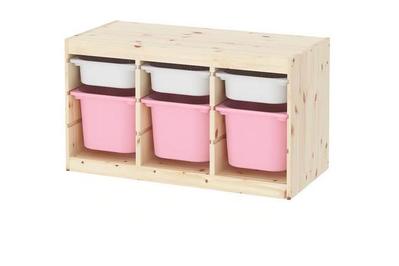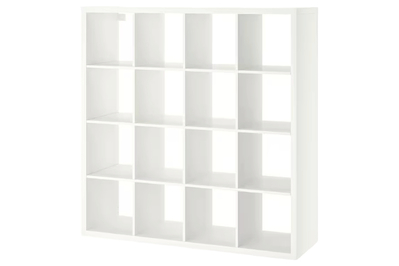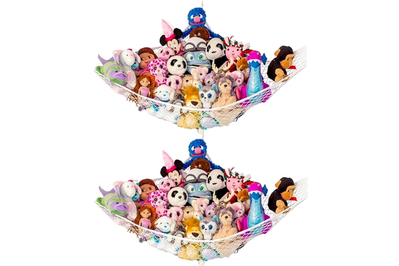
By Rachel Hurn and Wirecutter Staff
Optimizing home storage, especially in small spaces, only becomes more pressing when kids and their toys enter the equation. Over the years, parents on our staff have had varying degrees of success with many approaches. “We had bins and good intentions,” lamented senior staff writer Rachel Cericola, “but my son always used the floor.”
We can’t promise any miracles. But when it comes to toy storage, some methods work better than others, and the ideas here should be versatile enough to handle most needs. If you have effective solutions of your own, we’d love to hear about them in the comment section below.
Advertisement
SKIP ADVERTISEMENTReliable shelves that can be configured to meet your needs

This customizable shelving system is an easy way to sort loose toys, both large and small.
Buying Options
The IKEA Trofast Storage Combination is what several Wirecutter parents use to keep their kids’ bedrooms and play areas organized. The frames come in multiple sizes and configurations, so you can easily customize the system to fit your space. The drawer bins are available in four sizes (and a few colors), so you can choose a shallow bin to hold smaller items and deeper ones to fit larger toys or to hold more. When building with Lego, for example, kids can easily pull a drawer or two out to use on the floor, and then—ideally—put them away when they’re done. (Trofast systems are among our recommendations in our dedicated guide to the best Lego sorting and storage tools.) Other drawers can hold things like action figures, Hot Wheels, and costumes. And, of course, there’s the all-important miscellany drawer.
Wirecutter staff have devised some creative ways of putting the Trofast to use. You can combine two (or more) Trofast units, anchoring them together and into the wall—a critical safety precaution you should take for any large furniture. Adding a lid makes the bins stackable, which makes it simple to store toys that aren’t getting much love or that you want to set aside for a younger sibling. We’ve found that if you hide away the toys your kids are tired of playing with and bring them out again a year later, they often feel brand-new.
Senior staff writer Jackie Reeve has used Trofast bins on bookshelves instead of slotting them into the frame. She then slaps on labels and pictures of what’s inside on all the bins, and says her kid is pretty good about keeping everything sorted and organized. In a larger play area, it’s also possible to mount the Trofast frames under a sheet of plywood, creating a large table for trains, Legos, and other toys, with all the drawers below to keep the toys close at hand. And once your kids outgrow them, you can repurpose them for tool storage.

This adaptable cubed organizer comes in four-, eight-, and 16-cube configurations.
Buying Options
A similarly flexible system but without the plastic, the IKEA Kallax Shelf Unit can be customized with drawers, doors, hanging organizers, or fabric or rattan bins. You can also put the shelves on casters, but for kid use, it’s best to anchor them into the wall to keep them safe from tipping. (And to be doubly safe, orient them horizontally on the ground.) We like that the Kallax frames come in four-, eight-, and 16-cube configurations, so it’s versatile enough for different uses and lengths of walls.
The cubes are big enough for most kids books or even large toys. Senior editor and father of three Harry Sawyers has a four-cube and an eight-cube, both of which are nearly 10 years old. He says that they’re no longer in perfect condition, but they have withstood a lot of abuse and have survived three moves. Best of all, as the kids outgrow their toys, the Kallax can pull double duty as a bookshelf.
Soft bins with cute critter themes

These sturdy canvas bins liven up the nursery while also keeping soft toys or odds and ends stowed away.
This is basically the same soft storage bin but taller and with handles for easy toting to the washer. It can just as easily store a pile of stuffies.
Buying Options
These roomy storage bins are lightweight and convenient for quick cleanup. They’re made of a sturdy but flexible canvas, so you can fold and store them easily when they’re not in use. We like that the bins are each decorated with a different cute felt animal appliqué and colored trim, which adds some fun while also making it easier to keep different kinds of toys separate without additional labeling.
We also like the company’s taller laundry basket, which can just as easily store stuffies as dirty clothes. Unlike the storage bins, the hamper has handles as well as a mesh bottom. Senior editor Kalee Thompson has 3 Sprouts bins in both styles that her kids have used for more than five years. They still look like new, and the Octopus-themed hamper, once a blanket and stuffy depository, has fully transitioned to its intended use as a hamper for a kid who is now old enough to do his own laundry.
Advertisement
SKIP ADVERTISEMENTRigid bins with a grown-up aesthetic

This three-pack of bins is made of hard plastic, available with wooden or plastic lids, and looks just as nice storing toys as grown-up items.
Buying Options
Price includes shipping (FINAL SALE)
These are the same handsome, stackable bins, but they are slightly bigger than the largest trio size and have a soft felt exterior.
Buying Options
If you’d rather have more adult-looking storage for your kids’ rooms, where items like train tracks and art supplies are easy to access but out of sight, we like the Open Spaces bins, made of durable, hard plastic and available with wooden or plastic lids (or without lids).
The Bin Trio comes with three bins in three sizes—small, medium, and large—with the largest coming to a generous 17.5 by 11.5 by 8.5 inches. The medium and large sizes have cutouts for hand-holds on each short end, providing a good grip for toting from place to place, even when filled with heavy items. The cream-colored, opaque heavy-duty plastic conceals the contents, which we find more orderly than a basket or cubby with items spilling out of the top. You can also label the bins on the hand-holds to easily remember what’s inside. We haven’t tested the plastic lids, but the wooden lids feel solid and high quality. They fit neatly on top without sliding and are easy for small hands to take off and put back on. They’re also easy to wipe clean, thanks to their smoothly sanded texture.

The company’s Large Felt Storage Bins are slightly larger than its largest plastic bin—19 by 12.5 by 10 inches—with the same wooden lids. And unlike other felt storage bins we’ve seen, these have structured sides covered in soft matted fabric, so they’re sturdy enough to stack as well as beautiful to look at.
And since the Open Spaces bins look so good, they work just as well storing teen or adult items, making them likely to get many years of use in a household.
Canvas bags that make cleanup a cinch

These canvas, drawstring storage bags have whimsical exterior designs and, when laid flat, play-mat scenes for imaginative play.
Buying Options
These similar canvas, drawstring bags come in varying sizes and work great for transporting and storing toys with lots of small pieces. They also can double as play mats.
Play Pouch Australia pouches and Swoop Bags are just canvas mats with eyelets around the edge and a colored string that cinches the bags tight, yet they work astonishingly well at wrangling small toy pieces. A single bag can store hundreds of Lego pieces or Matchbox cars when pulled closed and doubles as a play mat when open. This minimizes the scattering of errant pieces during play, which, in turn, minimizes the amount of painful plastic you end up stepping on. Senior staff writer and dad of four Doug Mahoney says the Swoop bag makes cleanup easier and faster than any bin he’s used in the past, and it takes up less space as well—it can even be hung on a hook.
The most obvious difference between these two bags is Play Pouch Australia’s whimsical designs, which are multipurpose—the Wow Town Track becomes a mapped canvas for cars and trains, Old McBussy’s Farm becomes a homestead for animal play, and the branded mats, like Paw Patrol and Barbie Dreamhouse, create backdrops for a kids’ themed collections. The original Play Pouch is also a foot wider in diameter than the Swoop Large Toy Storage Bag.
These soft bags are much easier for kids to move around on their own than big, rigid storage bins, which means it’s no problem for them to drag one into the kitchen to play while dinner is being made, but then move it back to their room before bedtime.
One additional benefit is that the soft cloth somewhat mutes the unique sound of sifting mounds of Lego. Plastic bins seem to only amplify that sound, which can become quite grating to even the most even-keeled parents.
Advertisement
SKIP ADVERTISEMENTSturdy cubbies that keep toys within reach

These strong, stackable cubbies hold a lot of toys and keep them accessible to little hands.
Buying Options
One of our editors got these Badger Basket cubbies in the dark brown color nine years ago, and they’ve held up well through two moves and two kids. They’re solid—you can stack them to use your space more efficiently or even sit on them (if you’re a kid or smaller adult). Kids are more likely to play with toys they can see or easily get to, and we like that these cubbies make toys accessible but also keep them reasonably tucked away. But because the individual bins are deeper—and darker—than those that pair with IKEA shelves, for instance, we’ve found that toys do tend to get mixed up in these cubbies.
The cubby comes in nine colors, and when your little-kid toy phase is through, you may find other uses for it. Our editor originally bought three in 2015; just one is still in use for toy storage, while the other two are storing bike gear and tools in the basement. These cubbies aren’t elegantly finished, but they’re a good value given their durability and versatility.
Hammocks where all those stuffies can hang out

This no-frills but functional hammock is sold in a two-pack and can hold a lot of little friends.
Buying Options
Some parents may prefer this hammock’s boho-chic look, but it’s smaller and four times as expensive as the other stuffy hammock we recommend.
Buying Options
One way to get control over an overwhelming but endearing stuffy addiction is to take to the walls. Instead of wasting valuable floor space on bins and baskets, try a hammock, like this one from Lilly’s Love (pictured above). The triangular nets come two to a pack, and each can hold a small militia’s worth of plush pals (assuming the three included hooks are adequately secured to the wall). You can choose from 10 color options, including pink, green, and rainbow.
If you’re into more of a boho look, this macrame option from Sasa Baby is one of the nicer knit versions we found. (In fact, the knit is dense enough that the company also suggests trying it out as a cat hammock.) It comes in four colors but is significantly smaller than the less-expensive hammock from Lilly’s Love.
Advertisement
SKIP ADVERTISEMENTHow we think about toy storage
You’ve got to be able to stand looking at it. Beyond keeping a living space uncluttered, toy storage is your main solution to seeing a living room full of brightly colored plastic, superheroes, and stuffed animals after your kids are asleep. Consider your toy storage as a part of your decor, as opposed to strictly a functional item, and you’ll probably be happier with it.
Shelves are a commitment. Though shelving can be a great option to pack a lot of storage in a small space, there’s also an advantage in portable bins that can be completely removed from a room—if, say, you’re hosting a party or you just want to relocate where your kids are playing. A benefit of good storage is its ability to refresh the supply of toys and activities and make them interesting again after a time out of sight. If you don’t like our picks for bins, any suitable basket can be convenient, even if it seems like it takes up a good bit of floor space for the amount it holds.
Put little boxes inside big boxes. Whether you’re storing toys on shelves or in bins, one key to keeping all the little parts organized is having designated smaller boxes where those pieces live when they’re not in use. Look for tacklebox-like compartmented cases for action figures and cars, larger divided containers to keep Lego pieces separated by project, and locking, lidded cases for collections of markers and crayons. This is really critical when you want to pack a larger bin or cabinet with a lot of little things without making it cluttered and disorganized.
Doug Mahoney, Chris Heinonen, Jackie Reeve, and Harry Sawyers also contributed reporting and toy organization hours to this guide.
This article was edited by Kalee Thompson.
Meet your guides
Rachel Hurn is an editor on the team responsible for baby and kid coverage at Wirecutter. She has previously been an editor at Maine Magazine, Maine Home+Design, Departures Magazine, and A Women’s Thing Magazine. She is currently looking for representation for her first novel.
Wirecutter Staff
Further reading
49 Easter Basket Ideas We Love
by Jackie Reeve
Easter falls on March 31 this year. We’ve searched for good-quality gifts to fill a basket, including art supplies, classic toys, spring-themed books, and—of course—the best candy.
The 51 Best Stocking Stuffer Ideas for Kids
by Ingrid Skjong and Wirecutter Staff
Stocking stuffers can be small but meaningful presents. Whether they’re traditional, whimsical, or practical, they add a final touch to gift giving.
The Best Kids Cooking Tools (That You’ll Love Too)
by Lara Rabinovitch
We’ve tested more than 45 pieces of kitchen gear to find those that are most worth investing in for younger cooks, whether they’re toddlers or teens.
The 43 Best Gifts for 3-Year-Olds
by Caitlin Giddings and Wirecutter Staff
Open-ended toys that inspire role-playing and beginner board games that encourage cooperation make great gifts for 3-year-olds.
Advertisement
SKIP ADVERTISEMENT
















